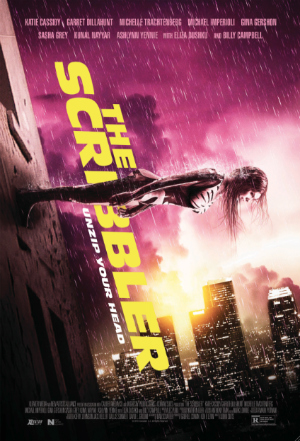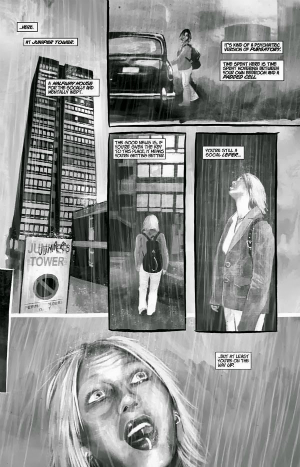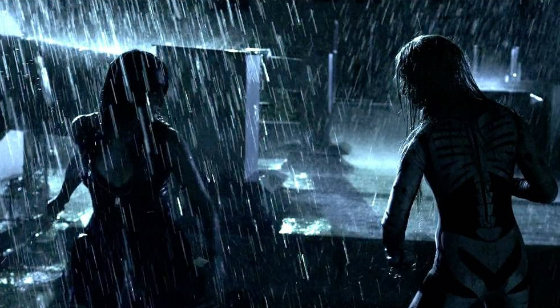EXCLUSIVE: Director John Suits on His Strange Comic-Book Movie The Scribbler
 |
There’s a comic-book movie opening tomorrow, but it’s not like any others that have come out this year.
Katie Cassidy, Arrow‘s Laurel Lance, stretches her acting muscles and her body while shedding clothes to play Suki, a troubled girl with multiple personalities, including one who apparently leaves backwards-written messages on her skin and furniture. Using a new experimental technique, her doctors try to eliminate her extra selves from her head one by one – but what if Suki herself is one of the fake personalities?
Set in a surreal, colorful world where scribbles appear on the skin and colors shift like moods, this is a unique film with many modern scream queens like Sasha Grey, Eliza Dushku, Gina Gershon, Michelle Trachtenberg and Ashlynn Yennie. But the director can explain it better than I can…
Luke Y. Thompson: So tell me about how this all came together. Were you a fan of the comic originally? Was this something that came to you? What was the deal that got this movie going?
John Suits: Well it actually was a bit sort of backwards as to how it usually goes. We were kind of searching for material, and came across the script before the comic, then read the comic and in addition to it, were like, “Holy crap, this comic is amazing as well!” The comic, having a sort of graphic novel component to it as well, was extremely helpful in starting to form a visual style. And also having Dan [Schaffer], the writer of the comic, write the screenplay, it was great, because you’re able to do a back-and-forth, and since he was the originator of the concept of the comic book, it was really important to have him as involved as possible, to make sure it was staying true to its essence. So yeah, that’s how we came to it.
LYT: You’ve done something very difficult, which is you’ve found a comic-book movie which must have been extremely difficult to pitch to producers. Was it a tough sell, or did the fact that it was a comic book give you the back-up that you needed to get it green lit?
JS: Well, it was actually – I’m part of this production company that Gabriel Cowan, my producing partner and I run, and we kind of have a different mode, where we find content that we respond really strongly too. If we feel that the content is really strong and it’s interesting and speaks to us, that we have the ability to be, like, “Let’s go make this!”
So Gabe and I have been making – I think we’ve done about 18 features at this point, in more of a producing capacity, so it gave us the ability to be a little bit more adventurous than, I think, you’re right – if there was a green lighting system in place, it would be very difficult to run it up the ladder, because it is so different, and I guess kind of unique to what a normal comic book movie is supposed to be, I guess.
LYT: Just looking at it – I’m not going to ask what the specific budget was, but if it makes sense, it’s one of those things that I can tell it looks bigger-budget than it probably actually was. How do you go about pulling that effect off?
JS: Well, that again – that’s kind of the amazing thing about technology these days. We have access to the same cameras that these $50 or $100 million dollar movies are used. We had, essentially, the craft services budget of one of those movies. But with that technology, as long as – you know, we had an extremely talented cinematographer, Mark Putnam, that we have done a bunch of movies with, and we were able to really sit down and create a visual style with the production designer, the costume designer, and the DP, and just put a lot of effort into making sure that stylistically everyone was on the same page.
Again, we all have many copies of the graphic novel that we marked up. I think through that process, we were able to create this uniform look, and thank you for saying that. I’m glad it looked bigger budget than it is. That was kind of our hope and desire, and I think that’s kind of a neat thing of the age we’re living in. I think budgets aren’t as limiting as they were 5 or 10 years ago.
LYT: All of the scribbling effects – was that all CG, or was there any practical element, or maybe even any hand-drawn element to it?
JS: So, very astute! There was – it was a combination of where we had practical make-up that our make-up team would put on Katie for certain scenes, and then other times, it was digital enhancements, where we would put the tracking marks, knowing we were going to add moving scribbles. Sometimes it would be where there would be a practical mix of moving scribbles, so we would – let’s say, with her face, her face would be covered in scribbles, but then we would also add digitally imposed moving scribbles on top of that.
So it was very much – some shots it’s purely digital, some shots it’s purely practical, and then other shots it’s kind of a combination of practical and digital.
 |
LYT: Was it tough to persuade as many actresses to get naked as you did?
JS: [laughs]Well, it’s actually a funny sort of story that way. I think they wanted to do it, so it wasn’t really ‘persuading’ in that regard. With, obviously, a character like Emily, who has vestiphobia and the fear of clothing, so she doesn’t wear clothes – anybody that was reading with us about the part knew what it entailed. That at least made the conversation a little easier in terms of they weren’t, like, “Wait a minute! This character’s naked?” I guess it kind of came with the film, what was already embedded and inherent in the script. They came ready – with Ashlynn and with Katie, they were very committed to the project, and put a lot of work in. Especially, Katie was amazing and did so much research and so much work, and was fully committed and really wanted to fully engulf herself in the character.
LYT: So how many of the cast were the process of a whole bunch of meetings, and how many were first choice, right there?
JS: A lot of them were first choices, and so we got really lucky that way. There definitely were some times where there would be a certain person, and we’d go, like, “Oh, that’s an interesting idea. I’m not sure,” and then you’d have the meeting and meet with them, and get blown out of the water, and go “Oh my gosh, this is them!” I hadn’t seen that side of them, but then you meet them and see what they’re like, and if they can really do it. It might be different than what they’ve done before, content-wise, but that they were – I was really impressed with a lot of our cast – the understanding the material that they brought to it. It was really neat.
With Katie, there was a lot of character building that we did together, and a lot of it that she just did alone, where she researched it and really – she went to a mental institution and was watching people with dissociative identity disorder, and trying to identify the personalities. It was a much more involved process, so it was really cool from that aspect, to watch the work and sort of, in a lot of case, just sort of have to guide or encourage it, but they’re doing so much on their own.
LYT: Here’s a deeper question. As a creator of movies, do you feel like there’s an analogy between trying to kill off the individual multiple personalities, and when you’re telling a story and you’re killing off the characters, do you feel like you’re killing off parts of your personality as you do that?
JS: A lot of the time, yes. [chuckles]I think making movies, in general, you kill off parts of your personality in the process, just by how exhausting it can be! [laughs]But yeah, I mean – I think that’s a great analogy for it. It’s also an interesting thing, when you go to make a film, because obviously there’s – a lot of times people look at who directed it, but it’s just so much of a team effort, and about every individual from top to bottom, and just the sort of blood, sweat and tears that goes into making any movie. It’s always incredible to see people working that passionately.
And then what’s sad, in terms of killing off personalities, is you become this – you’re at summer camp, and you become this little team, this unit, and then a lot of people, after you’re done, you hardly get to see again. You’re so close to them in spending 12 or 14 hours a day with them for basically a month to two months straight. So I think a lot – that’s a great analogy for many parts of the film making process.
LYT: Did you guys also watch movies like Identity and say “Let’s not do it that way?”
JS: [chuckles]That was part of it! There’s definitely – there’s those types of films that get – it’s funny too, because I think a lot of people think it’s going the Identity route in some way or something, and you know, there’s a lot to be learned from people that got it right and there’s a lot to be learned from people that, you know, maybe didn’t, or that weren’t as successful in certain ways of getting the tone you want to achieve.
So I think definitely in the research process with Gabe and with Mark, our DP, and Kathrin [Eder], our production designer, and all of them – there’s a lot of movie watching, like “Here’s what we’d like it to be like, and here’s what we wouldn’t like it to be like.” I think that was also good in terms of, as I mentioned earlier, that sort of symbiosis where we all were on the same page and knew what we were trying to achieve.
 |
LYT: You have a character towards the end say “Don’t try to analyze this logically” to the detective. Is that a message somewhat to the audience, as well?
JS: I think somewhat, yes. You can ask Dan, the writer, to make 100% sure! [chuckles]But I think that’s right. It’s an interesting thing in watching the story a little bit, it’s much more thematically about individuality versus conformity, and there are sort of rules and regulations of storytelling, of film making, of all those different aspects, and I think the film itself doesn’t – the writer is such a brilliant individual that I was hoping to do any bit of the script justice. But the film is extremely layered, and in reading the script, I had to read it over and over and over again to try to get all of those elements. It’s also a thing that doesn’t sort of transpire in a logical sort of traditional structure, in a lot of ways. So it’s – I think that, again, it’s a good line in there where he does sum up in a nice way, maybe a little nod to the audience – “Hey – listen to her!” [chuckles]
LYT: Is the writer satisfied that you did do it justice now?
JS: I hope so! He’s such a nice guy – he seems to be very supportive of the film, and really on-board with it, and to feel really good about it, so that made me feel good, and Gabe as well. We tried to keep him involved in the process as much as possible, and sent them cut after cut and got his notes. Also, with Ken Levin as a producer on it who works with Dan a lot – we just tried to keep them as involved in the process as we could, and I think as a result, he’s very satisfied with the outcome. Having that be the goal, I think that made us all feel good at the end of the day.
LYT: Location-wise, was this on a sound stage? Was there actually an exterior building? There’s obviously some digital enhancement, but how much of this was actually shot on a location, versus being created in a computer?
JS: So it was, again, a bit of a combination, where the exterior of the building is a building, but then it had visual effects. The building was only six floors, I believe, so then when you saw anywhere above the sixth floor, that was digital. So we kind of took the look and the structure of the building and extended it up another eight floors.
Similarly, with the space itself, we shot it all at this location which is this sort of abandoned hospital called Linda Vista, and we went in there and our production designer did an amazing job with her team, of going in there and distressing the rooms, and really trying to make it look and feel like the graphic novel.
So we kind of had a bunch of spaces in that building that we picked to – some of them, from scratch, kind of like a stage, where we would build the room out from scratch, in terms of the dressing and the walls and stuff. Some of them were we’d find a practical location and then try to enhance it to make it consistent with the other spaces. So it was all practical locations that would sometimes function like a stage, in that we would find an empty room and then dress it from the ground up.
LYT: My final question – I saw that you were a producer on Bad Milo. I was wondering if that did well enough that there will be a second Bad Milo?
JS: [chuckles]That’s a good question! I’m not sure, but speaking of what you were saying earlier, killing the personalities – I will very much miss Milo if that’s the last that I get to see of him. He was such a cute creature, and he definitely really enlightened all of us for the shoot. So not sure, but I hope it’s not the end of Milo.
The Scribbler opens in theaters and on-demand tomorrow.

